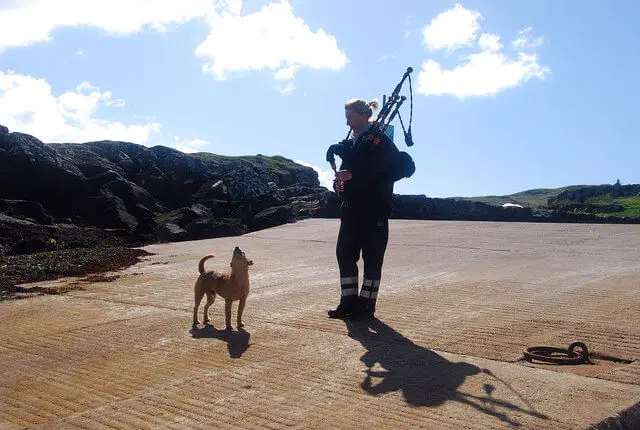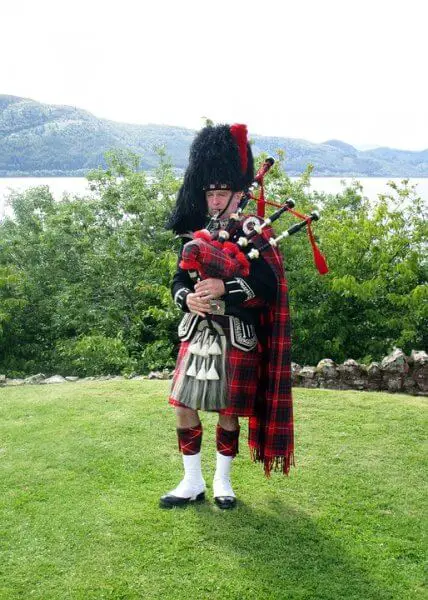Highland bagpipes are an iconic symbol of Scotland. They are also an instrument of both traditional and other musics played across Scotland today. Fair warning: even if you think you do not care for the sound of the pipes, you may be surprised at the level of emotion their sound evokes when heard on native ground.
Why is that so, and how did the Highland pipes come to be, anyway?


Some think the instrument that became the Highland pipes came from Egypt at first. Others think the idea came over from Ireland. What’s agreed is that, centuries ago, pipes soon found places at social occasions — weddings, funerals, worship services, and dances, for instance. They also became part of warfare, with pipers leading people into battle. All this, and the fact that playing the pipes was outlawed for a time (after the battle of Culloden, when many things to do with Highland life and community were banned) contributed to the reason the sound of the Highland pipes and the image of the Highland piper became an image of Scotland’s identity.
What are these instruments, really? How do they make that sound?
Highland pipes are woodwinds. That means they are in the same family of instruments as the flute, the oboe, and the cor anglais. The pipes have their own distinctive way of construction. There’s the bag, which holds the air the piper blows in through the blow pipe. There are the drones, usually three, two treble and one bass, which produce continuous notes, and the chanter, with holes (a bit like a whistle or flute) which the piper fingers to play the melody. It’s melody against the sustained notes of drones which creates the distinctive — and usually loud– sound of the Highland pipes.
What sort of music do people play on the Highland pipes? You might be familiar with marches such as played by pipe bands. Slow airs and hymns are popular band choices too, as well as reels, jigs, strathspeys, and hornpipes. Pipe bands, you will find, are part of military units, police divisions, and sponsored by companies, universities, and local organizations.
You will also find solo pipers, small groups of pipers, and bands which use the music of Highland pipes in varied ways. They may play all sorts of traditional music as well as original tunes and in some cases rock or pop music.
Where can you hear Highland pipers play when you travel to Scotland?

If you are in the larger cities, Edinburgh or Glasgow for instance, you will often find pipers busking along the main touristed streets. That is especially true in summer, although not limited to that season. In summer too you will often find pipers busking on roads near major attractions such as Glencoe or Eilean Donan.

If you re going to a formal dinner or other event you may find pipes used to pipe in the dignitaries at the start of things, too. Highland pipes may be part of worship services in many denominations and faiths, either as a regular thing or for special events. Saint Aloysius Church in Glasgow, for instance, has a Celtic mass near the end of January every winter which always includes the music of pipers, beginning with the processional at the start of the service.
Highland pipes are part of many concerts, as focus or along with musicians on other instruments. Every year in Glasgow in August you will find Piping Live! a major festival featuring music and performance of pipe bands. If you attend any Highland games, in Scotland or elsewhere across the world, you will surely have the chance to hear and see pipe bands.
Solo pipers ands band which incorporate piping are doing creative work in pipe music, both drawing on long tradition and moving it forward. Red Hot Chili Pipers, for instance, do what they’ve called bagrock, where Highland pipes and electric guitar take center stage on, yes, rock music. Top folk band Capercaillie, focused on song and melody, both traditional and original, often uses Highland pipes to fine effect. The band Seudan
offers a unique pipe sound with a bit of a different range than pipes usually hold. The late Gordon Duncan was master of creativity on Highland pipes; his compositions are often played by solo pipers and bands. Fred Morrison has been known to incorporate bluegrass into the sound of the pipes.
That’s just a small taste of what you may find in live and recorded performance on Highland pipes in Scotland. One place to learn more about the history and present of piping is The Piping Centre in Glasgow. In a future story, there will be more to explore about The Piping Centre.
Several recordings to explore:
Scottish Power Pipe Band Tartan Weave
Gordon Duncan Thunderstruck
Seudan self titled album Seudan
Capercaillie The Blood Is Strong
Side note: In this story I’ve been speaking of the Highland pipes, the kind you may be most used to seeing. There are two other sorts of pipes you will find most commonly in Scotland: uillean pipes, which have a bag strapped around the player’s waist, with air drawn in by activating bellows, and the border or small pipes, which among other things have a chanter with keys (like a clarinet or flute) allowing additional notes to be played. The uillean pipes are associated with Ireland and the small pipes with Northumberland, although both are played in Scotland.
Photograph of piper and her dog from the Isle of Eigg by Glenn Breaden
Consider subscribing to our stories through e mail, and connecting with us through your favorite social networks — and while you’re at that social network exploring, we invite you to keep up with our adventures by liking the Perceptive Travel Facebook page.
